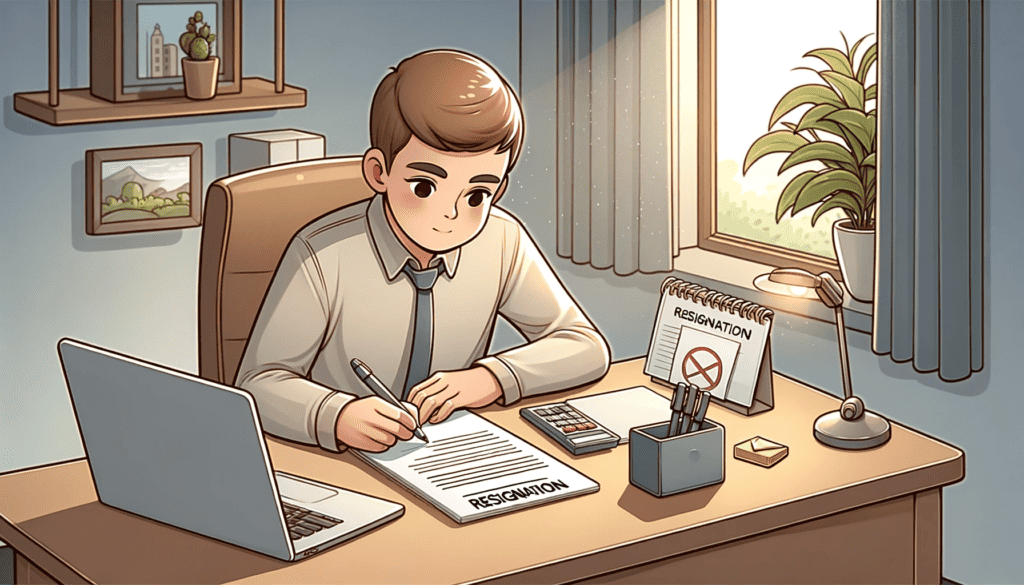Last Updated on January 26, 2024 by Daniel Boyce
“Is your job enhancing your life or draining it?”
This provocative question isn’t just a thought experiment; it’s a crucial reflection for anyone feeling trapped in a toxic work environment.

In today’s fast-paced world, job satisfaction is not just about the paycheck—it’s about mental and physical well-being, personal growth, and finding meaning in your work.
This article delves deep into the complex decision of how to resign from a toxic job.
We’ll explore the red flags of an unhealthy workplace, assess the toll it takes on your health, and discuss strategies for a graceful exit.
Whether you’re contemplating a career change or seeking advice on handling a difficult work situation, this guide offers valuable insights and practical tips.
Key Takeaways:
- Recognizing toxic work environment triggers
- Assessing the impact on health and well-being
- Consulting with mentors and mental health professionals
- Documenting your work experience for a strong resume
- Managing finances and compensation effectively
- Communicating your resignation professionally
Communicating Your Resignation
When an individual decides to resign due to a toxic work environment, conveying the decision professionally is crucial.
The communication should focus on tactfulness, maintaining relationships, and ensuring a seamless transition.
Writing a Professional Resignation Letter
A professional resignation letter serves not only as formal notice but also as a document that can reflect positively on one’s professional demeanor. In the letter, one should:
- Clearly state the intention to resign and the effective date of departure.
- Express gratitude for the experiences and opportunities provided during their tenure.
- Offer assistance during the transition period, such as training a replacement.
Samples are a useful starting point, and individuals can find guidance on structuring such letters from resources like Best Resignation Letters for Quitting a Toxic Work Environment.
Discussing Your Departure with Your Boss
The conversation with a boss about departing should be as composed and concise as the resignation letter.
Here are key points to remember:
- Request a private meeting to communicate resignation in person.
- Reiterate the points made in the resignation letter, emphasizing positive aspects of the job and the decision to move on.
- Be prepared to discuss the notice period and how you can support the transition.
Handling this discussion with care will help maintain a respectful relationship.

Maintaining Relationships with Coworkers and Management
Resigning from a position does not mean severing ties with all professional contacts.
To sustain relationships with coworkers and management:
- Communicate the departure to colleagues personally, where appropriate, after notifying the boss.
- Share contact information to keep in touch for future networking opportunities.
- Remain professional and supportive to the team until the last day of work.
Maintaining cordial relationships may provide support and references in future career endeavors.
Transitioning Out of the Job Professionally
When resigning from a toxic job, it’s crucial to maintain professionalism to ensure a positive transition.
This involves a meticulous handover of duties and exhibiting kindness, which reflects well on one’s character and future prospects.
Ensuring a Smooth Handover of Responsibilities
One should compile a detailed list of ongoing projects, their current statuses, and key contacts.
This could be in the form of a handover document, which will guide the successor or team in continuing work without disruption.
Organizing files, emails, and other resources in a manner that others can understand is also part of one’s professional responsibility.
Documentation should include:
- Task descriptions: Clear explanations of each responsibility.
- Progress updates: Current status of ongoing work.
- Deadlines: Important upcoming dates and milestones.
- Key contacts: Individuals or teams involved in each project.
Leaving with Kindness and Self-compassion
Resigning with kindness entails notifying one’s employer and peers with respectful communication, giving appropriate notice, and avoiding negative parting words.
Demonstrating self-compassion is also vital during this period as it can be a challenging transition; one should acknowledge their own courage in making a difficult but necessary decision.
To leave on a positive note, consider:
- Personal farewells: Thank peers for their collaboration and support.
- Constructive feedback: If appropriate, offer feedback in a constructive manner to help improve the workplace after departure.
- Self-reflection: Take stock of personal growth and areas for development, understanding that this experience contributes to one’s career journey.
Evaluating Your Decision to Resign
Before taking the significant step of resigning, one must thoroughly evaluate the situation.
This section will guide readers through the process of recognizing toxic triggers, understanding the toll on well-being, and the importance of seeking advice.
Recognizing Toxic Work Environment Triggers
In toxic work environments, employees may face persistent stress, unfair treatment, and a lack of support.
Here’s a list of signs indicative of a toxic workplace, which might influence the decision to resign:
- Constant High Stress and Burnout: If you find yourself in a persistently high-stress environment that leaves you feeling burnt out, with no support or mitigation from management, it’s a clear red flag.
- Lack of Communication and Transparency: An environment where communication is poor, decisions are made in secrecy, or there is a general lack of transparency can be toxic and demotivating.
- Unfair Treatment and Discrimination: Experiencing or witnessing unfair treatment, including discrimination, harassment, or favoritism, is a strong sign of a toxic workplace.
- Poor Leadership and Management: Ineffective, disrespectful, or abusive management can create a hostile work environment. This includes managers who micromanage, belittle, or fail to provide clear guidance and support.
- High Turnover Rates: If you notice a high rate of turnover, particularly among competent and highly valued employees, it can indicate deep-rooted issues within the organization.
- No Work-Life Balance: A workplace that demands constant overwork, with little regard for personal time or boundaries, can lead to physical and mental health issues.
- Feeling Undervalued or Unappreciated: Consistently feeling that your contributions are undervalued, or that your growth and achievements go unrecognized, can take a toll on your job satisfaction and self-esteem.
They should acknowledge specific signs that significantly diminish job satisfaction and affect performance.
Recognizing these red flags is a critical first step in making an informed decision to resign.
Assessing the Impact on Health and Well-being
Long-term exposure to toxic work environments can lead to stress-related ailments or even trauma, which can bleed over into one’s personal life.
Individuals should assess how their job is affecting their mental and physical health.
If they find their well-being is compromised, it might be time to consider a change.

Consulting with Mentors and Mental Health Professionals
Consulting with mentors who may offer guidance or mental health professionals can provide crucial support in navigating the decision to resign.
These consultations can help validate feelings, offer new perspectives, and equip one with strategies for establishing a fulfilling career path outside the current toxic environment.
What You Should Consider While Resigning
When planning to resign from a toxic job, it is crucial to systematically document the experience gained, refresh the resume, start the job search, and ensure financial stability.
Documenting Your Work Experience
An employee should begin by meticulously documenting work experiences and notable accomplishments.
Recording specific instances where he or she added value to the company and detailing responsibilities can serve as concrete evidence of his or her professional abilities.
This documentation will not only serve as a reference for future job applications but can help articulate the reasons for quitting if required.
- Responsibilities: Create a comprehensive list of tasks and roles.
- Achievements: Note any awards, recognitions, or successful projects.
- Skills: Enumerate new skills and expertise acquired during employment.
Updating Your Resume and Job Hunting
Updating one’s resume must follow a strategy that highlights relevant skills and experiences pertinent to the job market.
The candidate’s resume should present a trajectory that aligns with the intended career path.
They should then initiate job hunting by researching potential employers, networking within their industry, and applying to positions that match their qualifications and career goals.
- Resume Refresh:
- Skills: Prioritize recent, transferable skills.
- Experience: Tailor work history to the roles being targeted.
- Job Hunting:
- Network: Engage with professional contacts and attend industry events.
- Apply: Utilize job boards and company websites to submit applications.
Managing Finances and Compensation
Financial preparation before quitting is critical.
Employees should review their contracts for any clauses about resignation and understand the details regarding final compensation, including any owed bonuses or paid time off.
It’s advisable to save enough money to cover expenses during job transition – typically, at least three to six months’ worth of income.
- Financial Checklist:
- Savings: Aim to have a sufficient financial cushion.
- Compensation: Calculate final paycheck, including unused vacation days.
Transitioning Out of the Job Professionally
When resigning from a toxic job, it’s crucial to maintain professionalism to ensure a positive transition.
This involves a meticulous handover of duties and exhibiting kindness, which reflects well on one’s character and future prospects.
Ensuring a Smooth Handover of Responsibilities
One should compile a detailed list of ongoing projects, their current statuses, and key contacts.
This could be in the form of a handover document, which will guide the successor or team in continuing work without disruption.
Organizing files, emails, and other resources in a manner that others can understand is also part of one’s professional responsibility.
Documentation should include:
- Task descriptions: Clear explanations of each responsibility.
- Progress updates: Current status of ongoing work.
- Deadlines: Important upcoming dates and milestones.
- Key contacts: Individuals or teams involved in each project.
Leaving with Kindness and Self-compassion
Resigning with kindness entails notifying one’s employer and peers with respectful communication, giving appropriate notice, and avoiding negative parting words.
Demonstrating self-compassion is also vital during this period as it can be a challenging transition; one should acknowledge their own courage in making a difficult but necessary decision.
To leave on a positive note, consider:
- Personal farewells: Thank peers for their collaboration and support.
- Constructive feedback: If appropriate, offer feedback in a constructive manner to help improve the workplace after departure.
- Self-reflection: Take stock of personal growth and areas for development, understanding that this experience contributes to one’s career journey.
Coping and Moving Forward
Resigning from a toxic job can leave individuals with lingering negativity, which makes recovery pivotal.
They should focus on nurturing their well-being, identifying a healthy new work environment, and building their confidence for personal and professional growth.
Recovering from Negative Work Experiences
After leaving a toxic job, a person may experience a range of emotions, from relief to apprehension. It is vital to employ coping mechanisms to aid in this transition.
Time should be taken to recover by engaging in activities that reduce stress, such as mindfulness or regular physical exercise.
Moreover, professional help like talking to a counselor can be invaluable in processing what happened.
Resources like Indeed.com emphasize the importance of self-care during this period.

Seeking a Healthy Work Environment in Your Next Role
One’s personal life and well-being hinge significantly on the nature of the work environment.
As such, a priority in moving forward is pinpointing a workplace that epitomizes a healthy work environment.
Researching potential employers, looking into their company culture, and reading employee reviews are steps to take.
Insights from the Harvard Business Review can guide one in understanding what constitutes a supportive and growth-oriented workplace.
Fostering Personal Growth and Confidence
Developing a strong sense of confidence and fostering growth after a toxic job experience involves setting personal and professional objectives.
By creating short-term goals, they provide direction and a sense of achievement.
Learning new skills or improving existing ones is also beneficial, as it can lead to both increased self-esteem and marketability.
Articles from platforms like Forbes discuss strategies to move forward after leaving a harmful job situation.
Conclusion
In wrapping up our guide on how to resign from a toxic job, remember the essentials: recognize the warning signs, understand the impact on your well-being, and seek guidance.
Preparing for your departure involves not just updating your resume and managing finances but also maintaining professionalism in your communication and relationships.
Consider this as you move forward: resigning from a toxic job isn’t just an ending, it’s a brave step towards a fulfilling career where your job supports, not drains, your life.
Embrace this change with confidence and let it be a positive chapter in your career story.
Share your journey, engage in discussions, and let your experience be a beacon for others in similar situations.

Daniel Boyce, founder of AwareRecruiter.com, brings a diverse background in health, fitness, sales, and recruitment to career development. He’s passionate about helping professionals overcome workplace challenges and succeed in new roles. Daniel’s vision for AwareRecruiter.com is to create a comprehensive resource for career growth and satisfaction.

